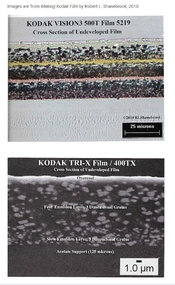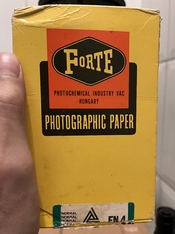O z
Member
Hi everyone!
Novice here. I’ve been lurking for a while now and thought It’s time that I start posting and
asking for constructive feedback.
Please share your thoughts.
Thanks in advance!
Oz

[Snapshot of negatives taken with iPhone]

[Positive image Inverted quickly using Lightroom app]
Objective: trying to test if an inverted, color motion picture film, has the potential to behave in a way similar to having in-camera ND and orange filters, due to light being forced to pass through the remjet layer and the orange film base before hitting the light-sensitive layer of the film.
———
Film: I don’t know much about its origin other than the following: it’s a 200 ISO Kodak motion picture film that was repurposed as B&W negative film by a local lab. It has the code: “EK 16 1551 9638” printed on it, but I couldn’t find anything online about it.
For normal processing, the lab recommended using a simple baking soda solution to soften the remjet before developing it in B&W chemistry, then removing the remaining remjet manually while rinsing the film at the end.
———
Exposure: I reloaded a small clipping from the film into a spare canister (with remjet facing the lens) and shot a few frames using a Nikon F90x in broad-daylight at estimated ISO 6 (5 stops overexposure).
———
Process: I followed the times and instructions provided by the lab to establish a baseline. Pre-soaked it for 3 minutes, sat it in baking soda bath for another 3 minutes, then developed it for 20 minutes in D76 stock solution @ roughly 20°C. Agitation was continuous for the first minute then 5 light inversions every 5 minutes, stopped with water then fixed as usual. Remaining remjet was carefully removed underwater using my thumbs during the final rinse.
———
I Haven’t had a chance to try printing yet but I plan on doing so later tonight. Will post a follow up as soon as I can.
Will post a follow up as soon as I can.
Novice here. I’ve been lurking for a while now and thought It’s time that I start posting and
asking for constructive feedback.

Please share your thoughts.
Thanks in advance!

Oz
[Snapshot of negatives taken with iPhone]
[Positive image Inverted quickly using Lightroom app]
Objective: trying to test if an inverted, color motion picture film, has the potential to behave in a way similar to having in-camera ND and orange filters, due to light being forced to pass through the remjet layer and the orange film base before hitting the light-sensitive layer of the film.
———
Film: I don’t know much about its origin other than the following: it’s a 200 ISO Kodak motion picture film that was repurposed as B&W negative film by a local lab. It has the code: “EK 16 1551 9638” printed on it, but I couldn’t find anything online about it.
For normal processing, the lab recommended using a simple baking soda solution to soften the remjet before developing it in B&W chemistry, then removing the remaining remjet manually while rinsing the film at the end.
———
Exposure: I reloaded a small clipping from the film into a spare canister (with remjet facing the lens) and shot a few frames using a Nikon F90x in broad-daylight at estimated ISO 6 (5 stops overexposure).
———
Process: I followed the times and instructions provided by the lab to establish a baseline. Pre-soaked it for 3 minutes, sat it in baking soda bath for another 3 minutes, then developed it for 20 minutes in D76 stock solution @ roughly 20°C. Agitation was continuous for the first minute then 5 light inversions every 5 minutes, stopped with water then fixed as usual. Remaining remjet was carefully removed underwater using my thumbs during the final rinse.
———
I Haven’t had a chance to try printing yet but I plan on doing so later tonight.
 Will post a follow up as soon as I can.
Will post a follow up as soon as I can.
Last edited:











 The lab operator suggested that remjet would prevent light from passing through altogether. Glad I tried it anyway.
The lab operator suggested that remjet would prevent light from passing through altogether. Glad I tried it anyway.







